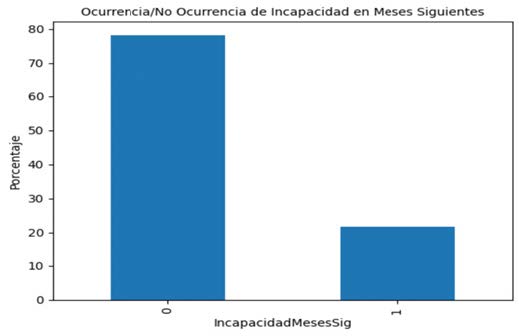Predicción del Ausentismo Laboral por Incapacidad: Una Aproximación desde los Modelos Lineales Generalizados
Prediction of Labor Absenteeism due to Incapacity: A Generalized Linear Model Approach
Barra lateral del artículo

Términos de la licencia (VER)

Esta obra está bajo una licencia internacional Creative Commons Atribución-NoComercial-SinDerivadas 4.0.
Declaración del copyright
Los autores ceden en exclusiva a la Universidad EIA, con facultad de cesión a terceros, todos los derechos de explotación que deriven de los trabajos que sean aceptados para su publicación en la Revista EIA, así como en cualquier producto derivados de la misma y, en particular, los de reproducción, distribución, comunicación pública (incluida la puesta a disposición interactiva) y transformación (incluidas la adaptación, la modificación y, en su caso, la traducción), para todas las modalidades de explotación (a título enunciativo y no limitativo: en formato papel, electrónico, on-line, soporte informático o audiovisual, así como en cualquier otro formato, incluso con finalidad promocional o publicitaria y/o para la realización de productos derivados), para un ámbito territorial mundial y para toda la duración legal de los derechos prevista en el vigente texto difundido de la Ley de Propiedad Intelectual. Esta cesión la realizarán los autores sin derecho a ningún tipo de remuneración o indemnización.
La autorización conferida a la Revista EIA estará vigente a partir de la fecha en que se incluye en el volumen y número respectivo en el Sistema Open Journal Systems de la Revista EIA, así como en las diferentes bases e índices de datos en que se encuentra indexada la publicación.
Todos los contenidos de la Revista EIA, están publicados bajo la Licencia Creative Commons Atribución-NoComercial-NoDerivativa 4.0 Internacional
Licencia
![]()
Esta obra está bajo una Licencia Creative Commons Atribución-NoComercial-NoDerivativa 4.0 Internacional
Contenido principal del artículo
Resumen
El ausentismo laboral representa un desafío crítico para la gestión del talento humano, con implicaciones económicas relevantes, efectos negativos en la reputación organizacional y riesgos para la competitividad empresarial. Este artículo examina los factores que inciden en el ausentismo laboral, con un enfoque en la predicción de dos aspectos fundamentales: el número esperado de días de ausencia de un empleado en los próximos tres meses y la probabilidad de que registre al menos un día de ausencia en ese mismo período. Para ello, se emplean modelos de conteo y de respuesta binaria, enmarcados en los modelos lineales generalizados, logrando predicciones de alta precisión de la ocurrencia de incapacidades laborales, a nivel individual, en una institución financiera colombiana. Además, desde las dos perspectivas de modelación se encontró que los factores que mayor influencia tienen sobre la ocurrencia de incapacidades laborales son el mes del año, el sexo, el tipo de contrato, el área de trabajo y el histórico de la cantidad de meses en los que el empleado ya había presentado incapacidad.
Descargas
Detalles del artículo
Referencias (VER)
Ali Shah, S.A.; Uddin, I; Aziz, F; Ahmad, S; Al-Khasawneh, M.A.; Sharaf, M. (2020). An Enhanced Deep Neural Network for Predicting Workplace Absenteeism, Hindawi Complexity, 5843932. https://doi.org/10.1155/2020/5843932
Araujo, Vanessa S.; Rezende, Thiago S.; Guimaraes, Augusto J.; Silva Araujo, Vinicius J.; de Campos Souza, Paulo, V. (2019). A hybrid approach of intelligent systems to help predict absenteeism at work in companies. SN Applied Sciences, 1(6), 536. https://link.springer.com/article/10.1007/s42452-019-0536-y
AWS, (2025). ¿Qué es la regresión logística?. https://aws.amazon.com/es/what-is/logistic-regression/
Berg, T.; Elders, L.; Zwart, B.; Burdorf, A. (2008). The effects of work-related and individual factors on the work ability index: A systematic review. Occupational and Environmental Medicine, 66(4), 211–20. https://oem.bmj.com/content/66/4/211
Borda, M.C.; Rolón, E.; Díaz-Piraquive, F.N. y González, J. (2017). Ausentismo Laboral: Impacto en la Productividad y Estrategias de Control desde los Programas de Salud Empresarial. Universidad del Rosario. https://doi.org/10.48713/10336_13583
Coussement, K., & Van den Poel, D. (2008). Churn prediction in subscription
services: An application of support vector machines while comparing two parameter selection techniques. Expert systems with applications, 34(1), 313-327. https://doi.org/10.1016/j.eswa.2006.09.038
Daza, F.M.; Perez Bilbao, J. (1997). NTP 443: Factores psicosociales: metodología de evaluación. https://www.insst.es/documents/94886/326962/ntp_443.pdf/35f6978d-1338-43c3-ace4-e81dd39c11f0
Fischer, JE; Genser, B; Nauroth, P; Litaker, D; Mauss, D. (2020). Estimating the potential reduction in future sickness absence from optimizing group-level psychosocial work characteristics: a prospective, multicenter cohort study in German industrial settings. Journal of Occupational Medicine and Toxicology, 15(1), 33. https://doi.org/10.1186/s12995-020-00284-x
Gil Bellosta, Carlos J. (2018). Modelos con Inflación de Ceros y Separación Perfecta. https://www.datanalytics.com/2018/04/11/modelos-con-inflacion-de-ceros-y-separacion-perfecta/
Gomes, J.M.; Lopes, F.M. (2022). Interpretability with Relevance Aggregation in Neural Networks for Absenteeism Prediction. 2022 IEEE-EMBS International Conference on Biomedical and Health Informatics (BHI). https://ieeexplore.ieee.org/document/9926870
IBM, (2025). Regresión Logística. https://www.ibm.com/docs/es/spss-statistics/saas?topic=regression-logistic
IBM, (2025). Modelos Lineales Generalizados. https://www.ibm.com/docs/es/spss-statistics/saas?topic=statistics-generalized-linear-models
International Labour Organization. (2020). Skilled Workers Matter. The business case for addressing absenteeism and turnover in Myanmar’s garment sector. https://www.ilo.org/publications/skilled-workers-matter-business-case-addressing-absenteeism-and-turnover-0
Instituto Colombiano de Normas Técnicas y Certificación (ICONTEC). (1996). Norma Técnica Colombiana NTC 3793. Salud Ocupacional. Clasificación, Registro y Estadísticas de Ausetismo Laboral, 1-2. https://www.studocu.com/co/document/uninpahu-institucion-universitaria-sede-principal/administracion/pdfslide-dfs/28685112
Isaac P., Jaime; Rivera, Gerson. (2021). Modelos Lineales Generalizados con R. Chapter 8: Regresión de Poisson. https://bookdown.org/jaimeisaacp/bookglm/regresi%C3%B3n-de-poisson.html
Kocakulah, M.C.; Kelley, A.; Mitchell, K.M.; Ruggieri, M.P. (2016). Absenteeism Problems And Costs: Causes, Effects And Cures. International Business & Economics Research Journal (IBER), 15(3). https://clutejournals.com/index.php/IBER/article/view/9673
Lawrance, N; Petrides, G; Guerry, M.A. (2021). Predicting employee absenteeism for cost effective interventions. Decision Support Systems, 147, 113539. https://doi.org/10.1016/j.dss.2021.113539
Management Solutions, (2023). Explainable artificial intelligence (XAI): Desafíos en la interpretabilidad de los modelos. https://www.managementsolutions.com/sites/default/files/minisite/static/22959b0f-b3da-47c8-9d5c-80ec3216552b/iax/pdf/explainable-artificial-intelligence-sp.pdf
Martiniano, A.; Ferreira, R. P.; Sassi, R. J.; Affonso, C. (2012). Application of a neuro fuzzy network in prediction of absenteeism at work. 7th Iberian Conference on Information Systems and Technologies (CISTI). https://ieeexplore.ieee.org/document/6263151
Montano, IH; Marques, G; Alonso, SG; Lopez-Coronado, M; Diez, ID. (2020). Predicting Absenteeism and Temporary Disability Using Machine Learning: A Systematic Review and Analysis. Journal of Medical Systems, 44(9), 162. http://dx.doi.org/10.1007/s10916-020-01626-2
Navarro, C; Bass, C. (2006). The cost of employee absenteeism. Compensation & Benefits Review, 38(6), 26–30. https://doi.org/10.1177/0886368706295343
Qaisar, S. (2020). Predicting Absenteeism at Work Using Machine Learning Algorithms. MJPS, 7(1). https://www.researchgate.net/publication/350955612
Raja, H.; Gupta, R. (2019). The impact of employee absenteeism on organizational productivity with special reference to service sector. International Journal of Research in Humanities, Arts and Literature, 4(7), 581–594. https://oaji.net/articles/2019/488-1558087237.pdf
Salonsalmi, A; Rahkonen, O; Lahelma, E; Pietiläinen, O; Lallukka, T. (2023). Associations between low parental education, childhood adversities and sickness absence in midlife public sector employees. Scandinavian Journal of Public Health, 51(6), 953 – 962.
https://journals.sagepub.com/doi/10.1177/14034948221087996
Sanchez, D.C. (2015). Ausentismo laboral: una visión desde la gestión de la seguridad y la salud en el trabajo. Revista Salud Bosque, 5(1), 182. http://revistas.unbosque.edu.co/index.php/RSB/article/view/182
Svärd, A; Lallukka, T; Oakman, J; Roos, E; Ervasti, J; Salmela, J. (2024). The Joint Contributions of Overweight/Obesity and Physical Mental Working Conditions to Short and Long Sickness Absence among Young and Midlife Finnish Employees: A Register-Linked Follow-Up Study. Obesity Facts, 17(1), 37 – 46.
https://doi.org/10.1159/000534525
Vafeiadis, T; Diamantaras K. I.; Sarigiannidis, G; Chatzisavvas, K. Ch. (2015). A comparison of machine learning techniques for customer churn prediction. Simulation Modelling Practice and Theory, 55, 1-9. https://doi.org/10.1016/j.simpat.2015.03.003

 PDF
PDF
 FLIP
FLIP







